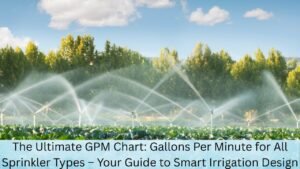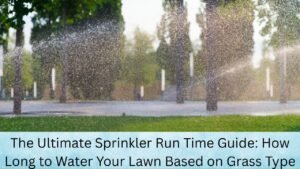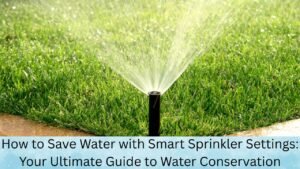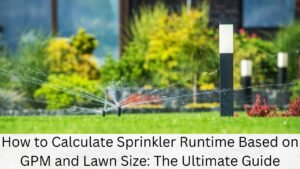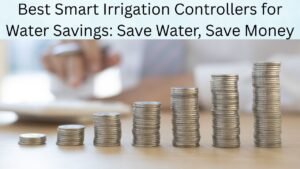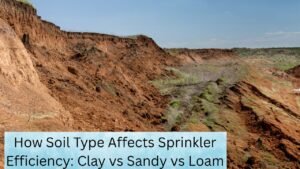Gardening in the U.S. often comes with its challenges, especially when it comes to managing water use. Whether you’re in the desert Southwest or the lush Northeast, choosing the right irrigation system can be the key to saving water, reducing bills, and keeping your plants healthy. In this article, we’ll break down Drip vs. Sprinkler systems, offering practical insights that help you pick the most water-efficient solution for your American garden.

Why Water Efficiency is Crucial for U.S. Gardens
Water is a precious resource, especially in areas where it’s scarce or costly. Efficient irrigation isn’t just about keeping plants alive—it’s about conserving water, saving money, and contributing to sustainable gardening practices. In fact, irrigation systems can account for up to 50% of household water use in the U.S. That’s why understanding how drip vs. sprinkler systems work can help you make an informed decision and ensure your garden is thriving while keeping your water bills low.
Understanding Drip Irrigation: Precision for Water Conservation
Bayer Global’s YouTube video below “The Drip Irrigation System” (May 18, 2017) explains how drip systems deliver water directly to plant roots with precision. This method reduces evaporation, limits runoff, and ensures plants get exactly what they need. It’s a proven way to grow healthier gardens while cutting down on overall water use.
Drip irrigation is a highly efficient system that delivers water directly to the plant’s root zone through a network of tubing and emitters. This method minimizes water waste, evaporation, and runoff, making it a perfect choice for regions facing water shortages.
Benefits of Drip Irrigation:
- Water Savings: Drip irrigation can cut water usage by up to 50% compared to traditional sprinklers, making it ideal for dry areas like California or Nevada.
- Cost Savings: In areas with high water costs, like parts of Florida or Southern California, a drip system can reduce water bills by $100–$200 per year.
- Precision Delivery: Water is delivered directly to the plant’s roots, preventing water wastage and promoting healthier, stronger plants. Perfect for vegetable gardens, raised beds, and flower beds.
- Lower Risk of Disease: Since the system waters only the soil and not the plant’s foliage, it reduces the chances of fungal infections and diseases.
Drawbacks of Drip Irrigation:
- Initial Installation: Setting up a drip system can be more complex and costly than sprinklers, with an average installation cost ranging from $300 to $600.
- Maintenance: Drip emitters can get clogged, especially in areas with hard water or high mineral content. Regular maintenance, like flushing the lines with vinegar, is required.
- Limited Coverage: Drip systems work best for smaller, targeted areas. They aren’t ideal for large lawns or expansive garden spaces.
Typical Water Usage:
Drip systems generally use between 0.5 to 2 gallons per hour per emitter, depending on the system’s design.
Understanding Sprinkler Irrigation: Wide Coverage for Larger Spaces
Sprinklers are designed to spray water across a wide area, making them ideal for large lawns or expansive gardens. There are various types of sprinkler systems, including oscillating, rotating, and fixed spray heads, each suited for different garden sizes and shapes.
Benefits of Sprinkler Irrigation:
- Wide Coverage: Sprinklers are excellent for lawns, flower beds, and ground cover. They can cover large, open areas more efficiently than drip systems.
- Lower Initial Cost: Sprinkler systems are generally cheaper to install, with costs ranging from $200 to $500 for standard residential setups.
- Low Maintenance: Once installed, sprinkler systems require minimal maintenance. Adjusting the sprinkler heads for better water distribution and cleaning them periodically is typically all that’s needed.
- Cost-Effective for Large Yards: For large, grassy areas, sprinklers are a more affordable option to water vast spaces compared to drip systems.
Drawbacks of Sprinkler Irrigation:
- Water Waste: Sprinklers tend to waste water due to evaporation and runoff, especially in hot climates. For example, in the desert Southwest, water loss due to evaporation can be as high as 30%.
- Uneven Watering: Wind and weather can cause sprinklers to distribute water unevenly, leaving some plants over-watered while others are too dry.
- Higher Disease Risk: Sprinklers wet the plant foliage, which can encourage fungal diseases, especially in humid climates like the Southeast U.S..
- Not Ideal for Specific Plant Needs: Sprinklers don’t cater to the specific watering needs of different plants, making them less efficient for gardens that need precision.
Typical Water Usage:
Sprinkler systems can use anywhere from 2 to 5 gallons per minute per sprinkler head, depending on the model and water pressure.
Drip vs. Sprinkler: A Side-by-Side Comparison
Smart Farming Inside’s YouTube video below “Drip vs Sprinkler Irrigation Systems | 1-1 Comparison For Garden Watering Plants” (published three months ago) breaks down the strengths and limits of both methods. The side-by-side look helps gardeners decide whether precision drip irrigation or broader sprinkler coverage fits their needs best. It’s a useful guide for anyone weighing efficiency against convenience in garden watering.
| Factor | Drip Irrigation | Sprinkler Irrigation | Water Efficiency Ranking |
|---|---|---|---|
| Water Efficiency | Excellent: Reduces water use by up to 50%. | Moderate: Prone to evaporation and runoff. | Drip: Excellent, Sprinkler: Moderate |
| Cost | Higher upfront cost, but long-term savings. | Lower initial cost. | Drip: Moderate, Sprinkler: Low |
| Ease of Installation | More complicated setup for larger areas. | Easy to install for lawns. | Drip: Moderate, Sprinkler: Easy |
| Maintenance | Requires regular maintenance to avoid clogging. | Minimal maintenance required. | Drip: High, Sprinkler: Low |
| Best For | Vegetable gardens, fruit trees, raised beds. | Lawns, large flower beds, ground cover. | Drip: Targeted, Sprinkler: Expansive |
| Water Pressure Needs | Low to moderate pressure. | Requires higher water pressure. | Drip: Low, Sprinkler: High |
| Weed Control | Excellent: Keeps surface dry. | Poor: Moist surface encourages weeds. | Drip: High, Sprinkler: Low |
| Disease Risk | Low: Prevents wetting of foliage. | High: Wet leaves promote fungal diseases. | Drip: Low, Sprinkler: High |
Key Factors for Water Efficiency in U.S. Gardens
Several critical factors influence the water efficiency of your irrigation system:
- Climate Zones: In dry climates like the Southwest or California, drip irrigation is essential to prevent water waste. In humid climates like the Southeast, sprinklers can be effective, but adjustments are needed to prevent excessive moisture on plant leaves.
- Water Costs: Regions with high water rates (California, Florida, Texas) will benefit more from drip irrigation, which reduces water consumption significantly.
- Plant Type: If you’re growing vegetables, fruit trees, or other deep-rooted plants, drip irrigation delivers water precisely where it’s needed, while sprinklers are better for lawns and large, shallow-rooted plants.
- Water Restrictions: Local regulations often promote water-efficient systems. For example, areas like Southern California have laws that require water-efficient irrigation methods, often favoring drip systems due to their lower water usage.
Choosing the Right System for Your American Garden
To pick the best irrigation system, you need to consider several factors that influence water efficiency:
Climate
- Dry Climates (California, Arizona, Nevada): Drip irrigation is the most water-efficient option, especially for vegetable gardens and trees.
- Humid Climates (Southeast, Pacific Northwest): Sprinklers are effective for lawns and ground cover but should be adjusted to prevent excess moisture on plants.
Water Costs & Restrictions
- If you live in a region with high water costs or strict water restrictions (like parts of California), a drip system will save you money by using water more efficiently. Some areas may even offer rebates for switching to more water-efficient systems.
Plant Needs
- Drip Systems: Best for specific plants like vegetables, shrubs, and fruit trees.
- Sprinklers: Ideal for large lawns or gardens with low-maintenance plants that don’t require targeted watering.
Optimizing Water Efficiency with Either System
To get the most out of your irrigation system, follow these tips:
- For Drip Systems: Use low-flow emitters and regularly check for clogs, especially in areas with hard water. In desert climates, consider using drip tape for vegetable rows to minimize evaporation.
- For Sprinklers: Set sprinklers to run early in the morning or late evening to reduce evaporation. Rain sensors can also help prevent watering during rainfall.
Conclusion: Making the Right Choice for Water Conservation
Choosing between drip vs. sprinkler systems comes down to your specific gardening needs, local climate, and water restrictions. If you want to maximize water efficiency, drip irrigation is often the best choice for targeted watering, especially in areas with water restrictions or high water costs. However, for larger lawns, sprinklers provide an affordable and efficient option.
Water conservation is more important than ever in the U.S., and picking the right system can make a big difference in your gardening practices. By considering your garden’s needs and local conditions, you can choose the most efficient system that saves water and money, all while keeping your plants happy and healthy!
